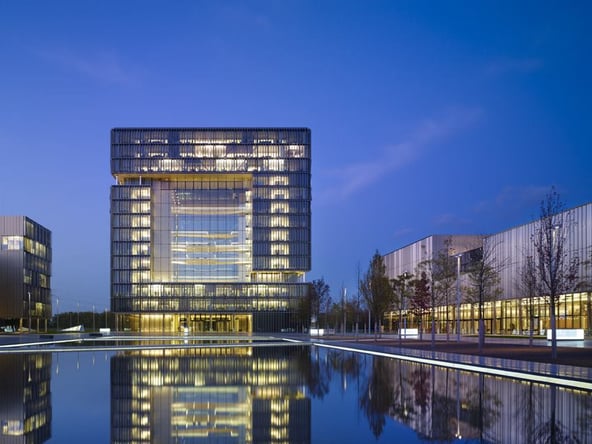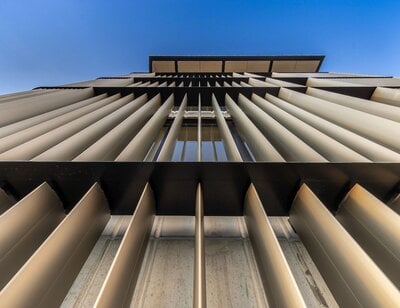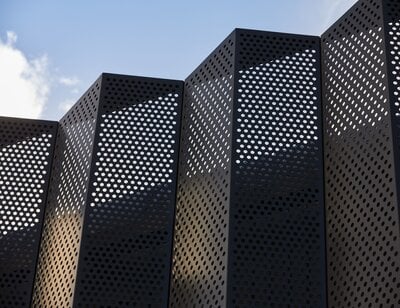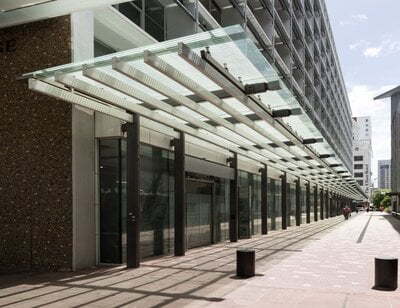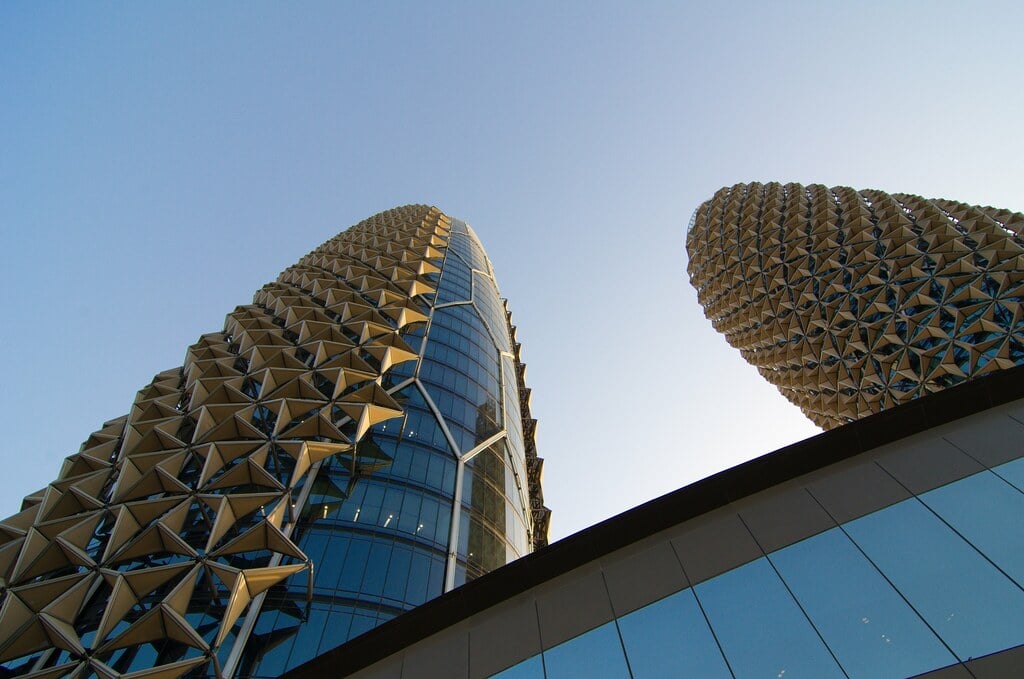
A Look at Smart Facades:
Technology has long been marching towards personalisation. With our experiences shaped by our interactions with the world around us, these experiences are becoming more adaptive. They respond to our responses. Think of it as a loop, our preferences and patterns of behaviour being reflected in algorithms which, in turn, influence our behaviour and impact our preferences. An app, smartphone or your social media feed is one thing of course. But what about a building? What can they do to react? Equally important is...what could they do?
Definition of a Smart Facade:
For the purposes of this article, we will define a smart facade as one which adapts to its environmental conditions and transforms itself in response to changes in those conditions. This definition essentially covers what may be called a kinetic facade, although in a broader sense, a kinetic facade may not be smart inasmuch as it simply has some provision for moving parts which may, or may not, react to environmental stimulus.
Benefits of Smart Facades:
One of the most pressing issues facing buildings is that of energy consumption. A paper by the United States Department of Energy states the buildings sector “accounts for about 76% of electricity use and 40% of all U.S primary energy use and associated greenhouse gas emissions”. One of the key points highlighted within the paper is the need for window and building surfaces with tunable optical properties.
If it wasn’t already abundantly clear buildings need to improve environmentally, Henry Kelly (Senior Scientist, University of Michigan) states the case rather well in his paper ‘The Potential for More Efficient Buildings’. He suggests it should be possible to effectively halve the electricity use in buildings (in the United States). Those types of energy savings (up to 12 quads of electricity from the US total of circa 100 quads annually) are significant and would go a long way to help meet the requirement of reducing greenhouse emissions by 80% by 2050.
So how can a smart facade help? By reacting to the environment (both internal and external) to help control heating, cooling and ventilation, a smart facade would be able to proactively manage a building's energy and control the comfort levels of occupants inside. This dual benefit should have significant appeal to both building owners and occupants. Such automatic control of thermal gains and losses will also have some additional benefit in regards to productivity gains amongst employees in commercial premises.
There is also another potential benefit from a smart facade. They can greatly improve the aesthetics of a building and turn something seemingly ordinary into something really rather magical and captivating. This is certainly the case with buildings such as the institut du Monde Arabe in Paris (although it might be considered a poor example of a kinetic facade in respect to it no longer being operable).
Examples from Around the World:
One of the best known examples is likely that of the Al Bahar Towers in Abu Dhabi. The Architects designed a responsive facade that moves, opening and closing in relation to the position of the sun at a given time of the day. The result is a building that is purported to reduce solar gain by as much as 50%, as well as vastly reducing energy use by minimising the need for resource intensive air conditioning.
Another smart facade which transforms in order to serve much the same purpose, although executed very differently, is the Kiefer Technic Showroom in Austria. Comprising 112 tiles that shift and move, opening up the windows behind them to the outside world, this facade can be controlled for individual preference with the occupants able to adjust the tile positions for their immediate area.
A final example of smart facade serving a similar purpose is that of the Q1 Building in Essen, Germany. 3150 kinetic feathers are employed to provide the required shading, moving based on the sun’s path and internal sensors.
We should note an example of a smart facade for aesthetic purposes. The Bund Finance Centre in Shanghai features a moving veil of 675 individual magnesium alloy tubes of varying lengths. As they move on a track, the varying length of the tubes combine to produce a quite wonderful and elegant overlapping facade of changing appearance, revealing and then concealing the space behind the facade.
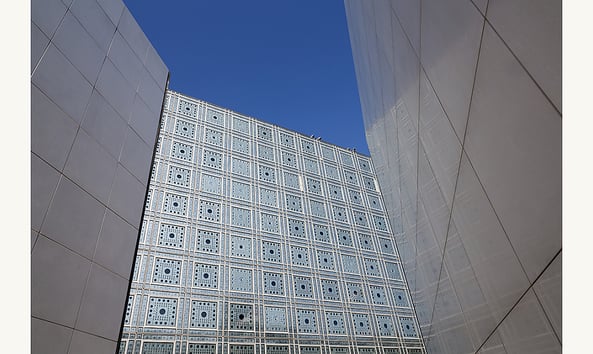
Considerations & Limitations:
That which moves can stop moving. Or move a little differently to how it is intended. Revisiting the previously mentioned Institut du Monde Arabe. With 16,000 moving parts there was always significant potential for something to fail. Not least that the design was, in all reality, ahead of its time. The materials used and mechanics involved were not advanced enough to cope with the design and vision of the architect.
This leads to the first consideration, which is one of what happens at the point of failure. In the case of the Institut du Monde Arabe, the design is of such intricacy and detail, it remains aesthetically beautiful even though it's inoperable. The same might be said for the Bund Finance Centre. It might be harder to lay the same claim to the Keifer Technic Showroom unless the point of failure occurred when the panels were in some sort of pleasing arrangement.
The Showroom has the primary purpose of controlling the solar gain. Aesthetic considerations aside (which are highly subjective anyway), if it fails then the underlying purpose of the design is void and will impact the buildings energy use and occupant comfort (or discomfort).
The second consideration concerns itself with maintenance. A quote attributed to Buckminster Fuller seems rather fitting; “If you build it like a machine, you must maintain it like a machine, not a building”. The cost and timeliness of proper maintenance would be easy to underestimate. Notwithstanding this is the underlying technology which may be employed. Indeed, it is only 13 years since the first iPhone revolutionised mobile communications. Given the lifespan of a commercial building is likely to be 50+ years, the forward thinking required to make sure any technology underpinning a smart facade does not become obsolete would be a seemingly impossible task.
Even where obsoletion is not likely to be an issue, the ease of maintenance must be a consideration. For example, can you easily access and replace any faulty parts?
The ease of maintenance aside, cost considerations cannot be ignored. If they place too high a burden on the building it is likely a scheduled occurrence of preventative maintenance is skipped, especially in adverse economic times.
This leads us to the maintenance programme itself. With so many complicated and interdependent components, a well documented yet easy to understand schedule of preventative maintenance is required. Planning for this in the tender stage of a project will aid in not only ensuring the on-going commitment to maintenance is both fully understood and costed, it will also place focus on the need for a comprehensive handover.
Back to the technology underpinning the operation of the smart facade. As already stated, it would be a seemingly impossible task to ensure whatever software is used as part of any control mechanism has an indefinite lifespan. However, much like there are some sensible precautions available when building a web platform, making sure the control mechanism used is based on either open-source software or has the support of a large company and well-known platform is advisable. Proprietary control systems can come with many fish hooks.
Control systems may also have some inherent fault or be open to interference from occupants or a change in intended use. This was the case with the Occidental Chemical Centre in Niagara Falls, a once grounded-breaking building that has since fallen into disrepair and in need of an expansive makeover. It seemingly never worked as intended and occupant alterations (such as the addition of an air conditioning unit between the building skins by one office) rendered it less than functional for its original, intended purpose.
It would be impractical to believe some change may not be called for at some point during the life of a building. The more in-depth the design and risk analysis is for a kinetic façade in the early design stages, the more successful the façade performance will be in the long run. Charles D Linn states "the most important thing to maintain is the client's passion and commitment for keeping the building operating properly - that is, if it was designed right in the first place. If it wasn't, then the most important thing is the designer's commitment to making it operate properly. If you don't have these, all bets are off."
The Future:
Where do we go from here and what is the future for smart facades? If an entire building can move and adapt, it stands to reason there might be some mixed model of smart facade whereby individual occupants can have their own preferences reflected in how the facade of their area of the building adapts to the environment, whilst not impacting the preferences of other occupants or undoing the energy saving of the building as a whole. Taking that a step further, the smart facade might react differently to different individuals who share the same space. Think of a luxury apartment complex where the facade reacts and changes to suit the preferences based on who is home. That is, if Mrs Smith is home then a certain adaptation of the facade is automated. If Mr Smith is home, his preferences are automated. When both are home, there is a different setting to reflect an agreed change by both parties.
Beyond that, who knows. But the neverending move towards personalizations and mass integrations via IFTTT and suchlike, would suggest the age of adaptation is here. It may be driven in large by environmental concerns at present, but it will likely accelerate when demanded by owners and occupants for reasons of comfort and preference. If the result is the same (environmental benefits) then that is no bad thing.
